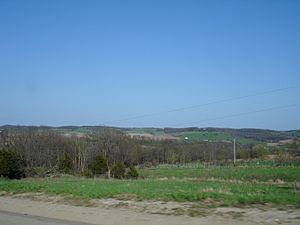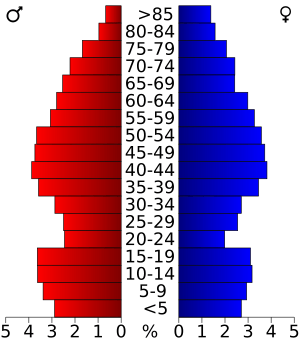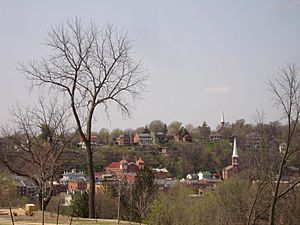Jo Daviess County, Illinois facts for kids
Quick facts for kids
Jo Daviess County
|
|
|---|---|

Hill terrain in the county, part of the Driftless Area
|
|

Location within the U.S. state of Illinois
|
|
 Illinois's location within the U.S. |
|
| Country | |
| State | |
| Founded | 1827 |
| Named for | Joseph Hamilton Daveiss |
| Seat | Galena |
| Largest city | Galena |
| Area | |
| • Total | 619 sq mi (1,600 km2) |
| • Land | 601 sq mi (1,560 km2) |
| • Water | 18 sq mi (50 km2) 2.9% |
| Population
(2020)
|
|
| • Total | 22,035 |
| • Estimate
(2023)
|
21,756 |
| • Density | 35.598/sq mi (13.744/km2) |
| Time zone | UTC−6 (Central) |
| • Summer (DST) | UTC−5 (CDT) |
| Congressional district | 16th |
Jo Daviess County (/ˈdeɪvɪs/) is the northwesternmost county in the U.S. state of Illinois. According to the 2020 census, it had a population of 22,035. Its county seat is Galena. Jo Daviess County is part of the Tri-State Area and is located near Dubuque, Iowa and Platteville, Wisconsin. As part of the Driftless Area, Jo Daviess County contains rugged terrain compared to the rest of the state. Within Jo Daviess County lies Charles Mound, the highest natural point in Illinois, as well as eight of the ten highest points in Illinois.
Contents
History
Jo Daviess County was formed in 1827 out of Henry and Putnam counties. It is named for Maj. Joseph Hamilton Daveiss, United States District Attorney for Kentucky, who was killed in 1811 at the Battle of Tippecanoe. The local pronunciation is "Davis". Jo Daviess County was founded exclusively by immigrants from New England. These were old stock "Yankee" immigrants, meaning they were descended from the English Puritans who settled New England in the 1600s. The completion of the Erie Canal caused a surge in New England immigration to what was then the Northwest Territory.
The end of the Black Hawk War led to an additional surge of immigration, once again coming almost exclusively from the six New England states as a result of overpopulation combined with land shortages in that region. Some of these later settlers were from upstate New York and had parents who had moved to that region from New England shortly after the Revolutionary War. New Englanders and New England transplants from upstate New York were the vast majority of Jo Daviess County's inhabitants during the first several decades of its history. These settlers were primarily members of the Congregational Church though due to the Second Great Awakening many of them had converted to Methodism and some had become Baptists before coming to what is now Jo Daviess County. The Congregational Church subsequently has gone through many divisions and some factions, including those in Jo Daviess County are now known as the Church of Christ and the United Church of Christ.
As a result of this heritage the vast majority of inhabitants in Jo Daviess County, much like antebellum New England were overwhelmingly in favor of the abolitionist movement during the decades leading up to the Civil War.
In the late 1880s and early 1890s Irish and German migrants began moving into Jo Daviess County, most of these later immigrants did not move directly from Ireland and Germany, but rather from other areas in the Midwest where they had been living, particularly the state of Ohio.
County border changes
- 1830 – The northern border of Illinois and Wisconsin was formally established. Until that time, several Wisconsin towns actually were under the jurisdiction of Jo Daviess County.
- 1831 – Rock Island County was formed from a part of the county, along with a new northern extension of Henry County and Putnam County.
- 1836 – Whiteside, Ogle, and Winnebago counties were formed from the southern and eastern sections of the county.
- 1837 – Stephenson County was formed from the eastern section of the county.
- 1839 – Carroll County was formed from the southern section of the county.
Geography
According to the U.S. Census Bureau, the county has a total area of 619 square miles (1,600 km2), of which 601 square miles (1,560 km2) is land and 18 square miles (47 km2) (2.9%) is water.
Climate and weather
| Weather chart for Galena, Illinois | |||||||||||||||||||||||||||||||||||||||||||||||
|---|---|---|---|---|---|---|---|---|---|---|---|---|---|---|---|---|---|---|---|---|---|---|---|---|---|---|---|---|---|---|---|---|---|---|---|---|---|---|---|---|---|---|---|---|---|---|---|
| J | F | M | A | M | J | J | A | S | O | N | D | ||||||||||||||||||||||||||||||||||||
|
1.1
27
9
|
1.3
33
14
|
2.3
45
25
|
3.3
59
36
|
3.7
71
47
|
4.6
81
57
|
3.3
84
62
|
4.4
82
60
|
3.6
74
51
|
2.5
62
39
|
2.6
45
27
|
1.6
32
16
|
||||||||||||||||||||||||||||||||||||
| temperatures in °F precipitation totals in inches source: The Weather Channel |
|||||||||||||||||||||||||||||||||||||||||||||||
|
Metric conversion
|
|||||||||||||||||||||||||||||||||||||||||||||||
In recent years, average temperatures in the county seat of Galena have ranged from a low of 9 °F (−13 °C) in January to a high of 84 °F (29 °C) in July, although a record low of −35 °F (−37 °C) was recorded in February 1996 and a record high of 103 °F (39 °C) was recorded in August 1988. Average monthly precipitation ranged from 1.14 inches (29 mm) in January to 4.58 inches (116 mm) in June.
Major highways
In Illinois, US 20 is designated the General Ulysses S. Grant Highway (often abbreviated the U.S. Grant Memorial Highway) and is the longest route in the United States. In eastern Jo Daviess County US 20 is one of the few areas that remain two-lane across the entire stretch of US 20. The road between Dubuque and Stockton was once known as the most dangerous stretch of road because of the hills and curves flanked by cliffs and valleys. Travelers were greeted with signs reminding them to drive carefully as they entered this stretch of road.
Adjacent counties
- Lafayette County, Wisconsin - north
- Stephenson County - east
- Carroll County - south
- Jackson County, Iowa - southwest
- Dubuque County, Iowa - west
- Grant County, Wisconsin - northwest
National protected area
State protected area
Locally protected area
Several areas are protected by the charitable organization Jo Daviess Conservation Foundation:
- Buehler Preserve
- Casper Bluff Land & Water Reserve
- Horseshoe Mound
- Schurmeier Teaching Forest
- Valley of Eden Bird Sanctuary
- Wapello Land & Water Reserve
Demographics
| Historical population | |||
|---|---|---|---|
| Census | Pop. | %± | |
| 1830 | 2,111 | — | |
| 1840 | 6,180 | 192.8% | |
| 1850 | 18,604 | 201.0% | |
| 1860 | 27,325 | 46.9% | |
| 1870 | 27,820 | 1.8% | |
| 1880 | 27,528 | −1.0% | |
| 1890 | 25,101 | −8.8% | |
| 1900 | 24,533 | −2.3% | |
| 1910 | 22,657 | −7.6% | |
| 1920 | 21,917 | −3.3% | |
| 1930 | 20,235 | −7.7% | |
| 1940 | 19,989 | −1.2% | |
| 1950 | 21,459 | 7.4% | |
| 1960 | 21,821 | 1.7% | |
| 1970 | 21,766 | −0.3% | |
| 1980 | 23,520 | 8.1% | |
| 1990 | 21,821 | −7.2% | |
| 2000 | 22,289 | 2.1% | |
| 2010 | 22,691 | 1.8% | |
| 2020 | 22,035 | −2.9% | |
| 2023 (est.) | 21,756 | −4.1% | |
| U.S. Decennial Census 1790-1960 1900-1990 1990-2000 2010 |
|||
As of the 2010 United States census, there were 22,678 people, 9,753 households, and 6,514 families residing in the county. The population density was 37.7 inhabitants per square mile (14.6/km2). There were 13,574 housing units at an average density of 22.6 per square mile (8.7/km2). The racial makeup of the county was 97.2% white, 0.5% Black or African American, 0.3% Asian, 0.2% American Indian, 0.9% from other races, and 0.9% from two or more races. Those of Hispanic or Latino origin made up 2.7% of the population. In terms of ancestry, 49.4% were German, 19.7% were Irish, 11.1% were English, and 8.5% were American.
Of the 9,753 households, 25.3% had children under the age of 18 living with them, 55.9% were married couples living together, 7% had a female householder with no husband present, 33.2% were non-families, and 28.4% of all households were made up of individuals. The average household size was 2.31 and the average family size was 2.81. The median age was 47.1 years.
The median income for a household in the county was $50,279 and the median income for a family was $60,381. Males had a median income of $38,372 versus $29,412 for females. The per capita income for the county was $26,819. About 5.6% of families and 8.4% of the population were below the poverty line, including 11.5% of those under age 18 and 6.4% of those age 65 or over.
Communities
Cities
- East Dubuque
- Galena (county seat)
Villages
Census-designated places
Townships
Jo Daviess County is divided into twenty-three townships:
- Apple River
- Berreman
- Council Hill
- Derinda
- Dunleith
- East Galena
- Elizabeth
- Guilford
- Hanover
- Menominee
- Nora
- Pleasant Valley
- Rawlins
- Rice
- Rush
- Scales Mound
- Stockton
- Thompson
- Vinegar Hill
- Wards Grove
- Warren
- West Galena
- Woodbine
Unincorporated communities
Historic site
Education
School districts (all K-12) are:
- East Dubuque Community Unit School District 119
- Galena Unit School District 120
- Lena-Winslow Community Unit School District 202
- Pearl City Community Unit School District 200
- River Ridge Community Unit School District 210
- Scales Mound Community Unit School District 211
- Stockton Community Unit School District 206
- Warren Community Unit School District 205
- West Carroll Community Unit School District 314
See also
 In Spanish: Condado de Jo Daviess para niños
In Spanish: Condado de Jo Daviess para niños









